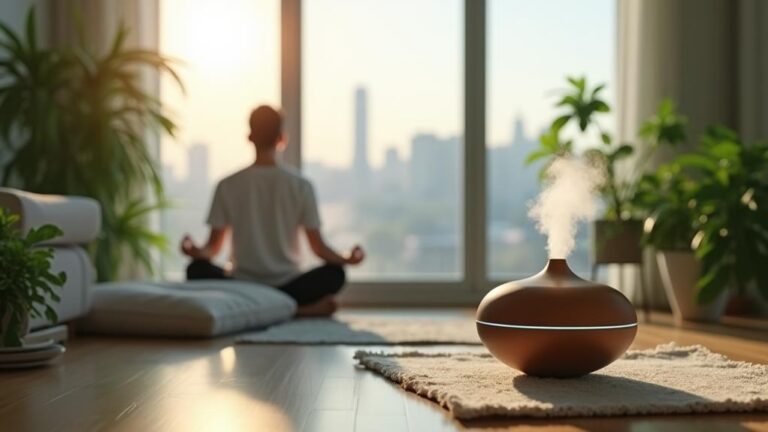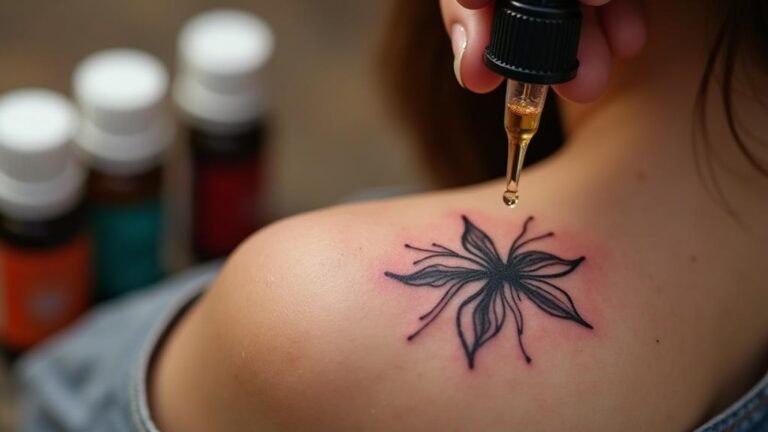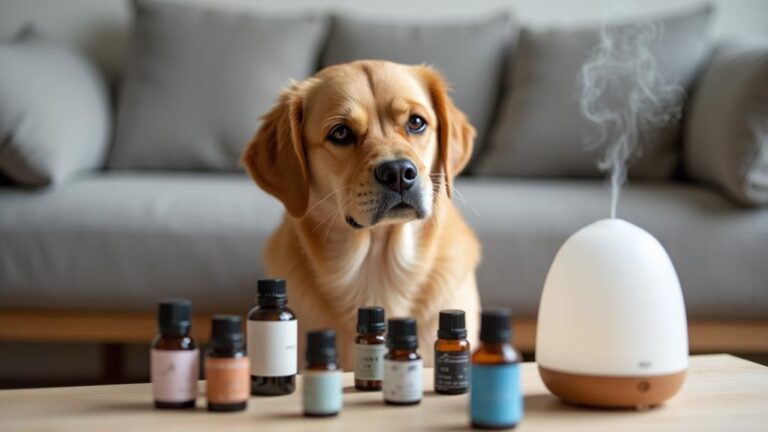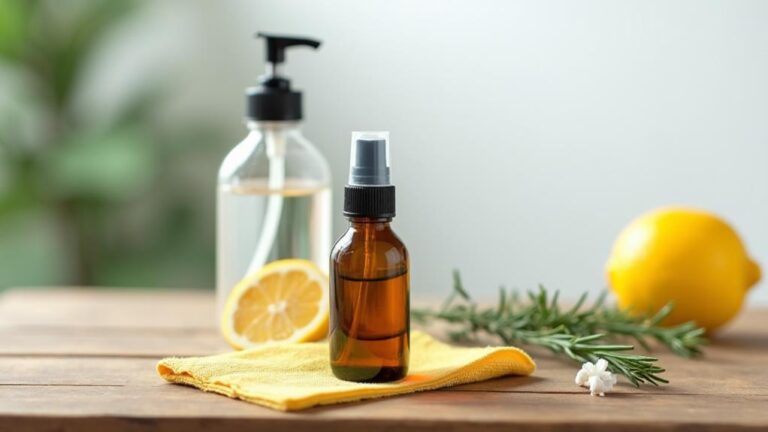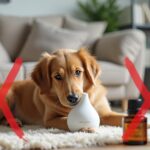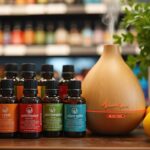You're likely familiar with the many benefits of essential oils, from their calming effects to their antimicrobial properties. However, when mixing different essential oils, you may unintentionally create a cocktail that's more hazardous than helpful. While combining oils might seem like a great way to create a unique scent or enhanced benefits, it can also result in unpredictable interactions and adverse reactions. As you explore the world of essential oils, it's vital to understand the potential risks of mixing them. But what exactly makes some combinations so hazardous, and how can you use essential oils safely?
Key Takeaways
- Certain essential oils can cause skin irritation and allergic reactions when mixed, so use with caution and dilute with a carrier oil.
- Blending oils with different chemical structures can disrupt their individual therapeutic effects and lead to adverse reactions.
- Mixing Tea Tree oil with Lemon oil and Peppermint oil with Eucalyptus oil can cause skin irritation and overwhelm the respiratory system.
- Consult a qualified aromatherapist before blending oils, especially if taking medications or using oils with strong properties.
- Pre-blended scents and single oils with complex scent profiles are safer alternatives to mixing essential oils.
Understanding Essential Oil Chemistry
When it comes to understanding essential oil chemistry, you're fundamentally dealing with a complex mixture of naturally occurring compounds.
Essential oils are comprised of various chemical constituents, including terpenes, esters, aldehydes, and phenols. These constituents interact and influence the overall properties and effects of the essential oil.
The unique combination and concentration of these chemical constituents can lead to distinct chemical reactions when essential oils are mixed.
For instance, the reaction between certain terpenes and aldehydes can result in the formation of new compounds, potentially altering the oil's aroma, therapeutic properties, and even its safety profile.
Understanding the chemical composition of essential oils is essential to predicting and managing potential interactions and reactions.
This knowledge allows you to make informed decisions when blending essential oils, minimizing the risk of adverse chemical reactions.
Skin Irritation and Allergic Reactions
Essential oil users often overlook the potential risks associated with skin irritation and allergic reactions when mixing essential oils.
When you combine different essential oils, you increase the risk of skin irritation, especially if you have sensitive skin. Certain essential oils, such as cinnamon, clove, and peppermint, are known to be highly irritating and may cause skin reactions, even in small amounts.
You should consider your skin type when using essential oils. If you have dry or sensitive skin, you may be more prone to irritation.
Irritation levels can vary depending on the essential oil and the individual's skin type. For example, if you mix two essential oils that are both irritating, the irritation level can be additive or even synergistic, resulting in a more severe reaction.
To minimize the risk of skin irritation, it is crucial to use essential oils in moderation and dilute them with a carrier oil. You should also perform a patch test before using a new essential oil or blend. This can help you identify potential skin irritants and take steps to avoid them.
Essential Oil Interactions With Medications
When you use essential oils, it's vital to ponder their potential interactions with your medications.
Certain oils can increase the risks associated with your medication or affect the dose you need, leading to adverse effects.
You should be aware of the possibility that some essential oils can interfere with your prescribed therapy, reducing its efficacy or causing unintended consequences.
Medication and Oil Risks
| Essential Oil | Medication | Potential Interaction |
|---|---|---|
| Grapefruit Oil | Statins | Inhibits drug absorption |
| Peppermint Oil | Antacids | Enhances drug absorption |
| Eucalyptus Oil | Diabetes Medications | Lowers blood sugar levels |
When using essential oils, it's vital to ponder their potential interactions with your medications. For instance, grapefruit oil can inhibit the absorption of statins, while peppermint oil can enhance the absorption of antacids. Similarly, eucalyptus oil can lower blood sugar levels, which may affect your diabetes management. Understanding these oil interactions can help you avoid adverse reactions and guarantee safe use. By consulting with your doctor, you can minimize the risks associated with using essential oils while taking medications. Always prioritize your health and safety by being aware of potential interactions between essential oils and your medications.
Essential Oil and Dose
In determining a safe dose of an essential oil, you must consider its potential interaction with your medications.
Essential oils can be highly concentrated and even small amounts can cause interactions. It's vital to assess the risk of adverse effects when combining essential oils with prescription medications.
To minimize risks, you should consult with a healthcare professional before using essential oils, especially if you're taking medications.
They can help you determine a safe essential dosing and oil measurement. When measuring essential oils, use a dropper or pipette to guarantee accurate measurement.
A general rule of thumb is to start with small amounts (typically 1-3%) and gradually increase as needed.
It's also essential to research the specific essential oil you're using and its potential interactions with your medications.
Some essential oils, such as grapefruit and bergamot, can interact with certain medications, including blood thinners and statins.
Oil Interfering With Therapy
Some essential oils, such as grapefruit and bergamot, can interact with medications like blood thinners, diabetes medications, and blood pressure medications.
For instance, grapefruit oil can inhibit the enzyme responsible for metabolizing certain medications, leading to increased levels of the medication in your system. This can increase the risk of side effects or even toxicity.
Oil potentiation can also occur when you use multiple oils that have similar effects, such as sedation or stimulation.
To guarantee safety, research potential interactions and consult with a healthcare professional before using essential oils if you're undergoing therapy or taking medications. This can help you avoid therapy disruption and verify safe and effective treatment.
Most Common Essential Oil Combinations
Within the domain of aromatherapy, essential oil combinations are often used to achieve specific therapeutic benefits.
When you're looking to create a blend, you must comprehend how different oils interact with each other. Oil blending is an art that requires a good understanding of scent preferences and the chemical properties of each oil.
You can experiment with various combinations to find the one that suits your needs.
- Relaxation blend: lavender, chamomile, and bergamot to promote relaxation and reduce stress.
- Uplifting blend: lemon, eucalyptus, and peppermint to boost energy and mental clarity.
- Pain relief blend: eucalyptus, wintergreen, and frankincense to reduce inflammation and alleviate pain.
- Mood booster blend: geranium, ylang-ylang, and rose to uplift and balance your mood.
When creating your own blends, remember to take into account the scent preferences of the individual using the oil.
Some people may be sensitive to strong scents, so it's crucial to test the blend before using it.
Oils to Avoid Mixing Together
You've learned about creating effective essential oil combinations, but it's equally important to know which oils to avoid mixing together.
Certain oils don't blend well due to their unique Oil Profiles, which can increase Blending Risks and compromise their therapeutic benefits.
For instance, mixing Tea Tree oil with Lemon oil can lead to skin irritation, as both oils have a high concentration of volatile compounds that can cause skin reactions when combined.
Similarly, blending Peppermint oil with Eucalyptus oil can be overwhelming to the respiratory system, as both oils have strong decongestant properties that can cause over-stimulation.
Additionally, combining oils with different chemical structures, such as mixing Sesquiterpene-rich oils like Sandalwood with Monoterpenol-rich oils like Lavender, can disrupt their individual therapeutic effects.
You must research and understand the unique characteristics of each oil before blending them to avoid adverse reactions.
By understanding which oils to avoid mixing together, you can minimize Blending Risks and guarantee the safe and effective use of essential oils.
Always prioritize caution and consult with a qualified aromatherapist if you're unsure about blending oils.
Safe Alternatives to Mixing Oils
Most essential oil enthusiasts find themselves in a predicament when they can't mix their desired oils due to potential adverse reactions.
This doesn't mean you have to give up on the idea of creating unique scents. Instead, look for safe alternatives that allow you to enjoy your favorite oils without compromising your health.
One option is to use pre-blended scents that are specifically designed to be safe for use.
These blends are created by experts who understand the properties of each oil and can combine them in a way that minimizes risks.
You can also explore oil synergies, where individual oils are used in a specific sequence or ratio to achieve a desired effect.
This approach allows you to reap the benefits of multiple oils without mixing them.
Some popular safe alternatives to mixing oils include:
- Using a single essential oil that has a complex scent profile
- Creating a layered scent by applying different oils at different times
- Incorporating fragrance oils or absolutes into your blends
- Opting for a pre-made blend from a reputable manufacturer
Best Practices for Essential Oil Use
To guarantee safe and effective use of essential oils, it's pivotal to establish a routine that prioritizes your health and well-being.
One key aspect is understanding essential dilution. Always dilute essential oils in a carrier oil before applying them to your skin.
The recommended dilution ratio is 1-3% essential oil to 97-99% carrier oil. This ratio helps prevent skin irritation and confirms the essential oil is absorbed effectively.
When selecting essential oils, prioritize oil quality.
Look for oils that are certified organic, sustainably sourced, and extracted using a suitable method for the specific plant.
Check the label for the botanical name, country of origin, and batch number.
These details indicate the oil's authenticity and quality.
Additionally, be aware of the oil's shelf life and storage requirements to maintain its potency and safety.
Frequently Asked Questions
Can Pets Be Exposed to Essential Oil Mixtures Safely?
As you wonder if pets can be exposed to essential oil mixtures safely, beware: even small amounts can trigger toxic reactions in pets, so it's vital for you, as a pet owner, to exercise extreme caution.
Are Essential Oil Mixtures Safe for Pregnant Women?
You're considering essential oil mixtures during pregnancy, but it's vital to weigh Pregnancy risks against potential Blended benefits. Research suggests some mixtures may alleviate symptoms, yet others can harm the fetus or trigger complications.
Can Essential Oil Mixtures Be Used in Food Recipes?
Imagine savoring a dish infused with the essence of herbs. You can experiment with essential oil mixtures in food recipes, but be cautious, as certain combinations can alter flavor profiles and disrupt culinary chemistry unexpectedly.
Do Essential Oil Mixtures Expire or Go Bad?
You need to know that essential oil mixtures, or oil blends, have a shelf life, typically 1-3 years, depending on storage conditions, quality, and individual oils' stability, which affects their potency and safety for use.
Can Essential Oil Mixtures Be Used in Humidifiers?
When using essential oil mixtures in humidifiers, you prioritize humidifier safety, as oil synergy can affect the blend's overall properties. Research the specific oils' interactions and potential risks to guarantee safe, effective use.
Conclusion
You've learned about the potential risks of mixing essential oils, but are you aware of the consequences of a single misstep? Combining oils without proper knowledge can lead to adverse reactions and interactions. To guarantee safe and effective use, prioritize oil quality, dilute essential oils in a carrier oil, and follow safety guidelines. Consider pre-blended scents, single oils with complex profiles, or layered scents as alternatives to mixing. Always put caution first when working with essential oils.




